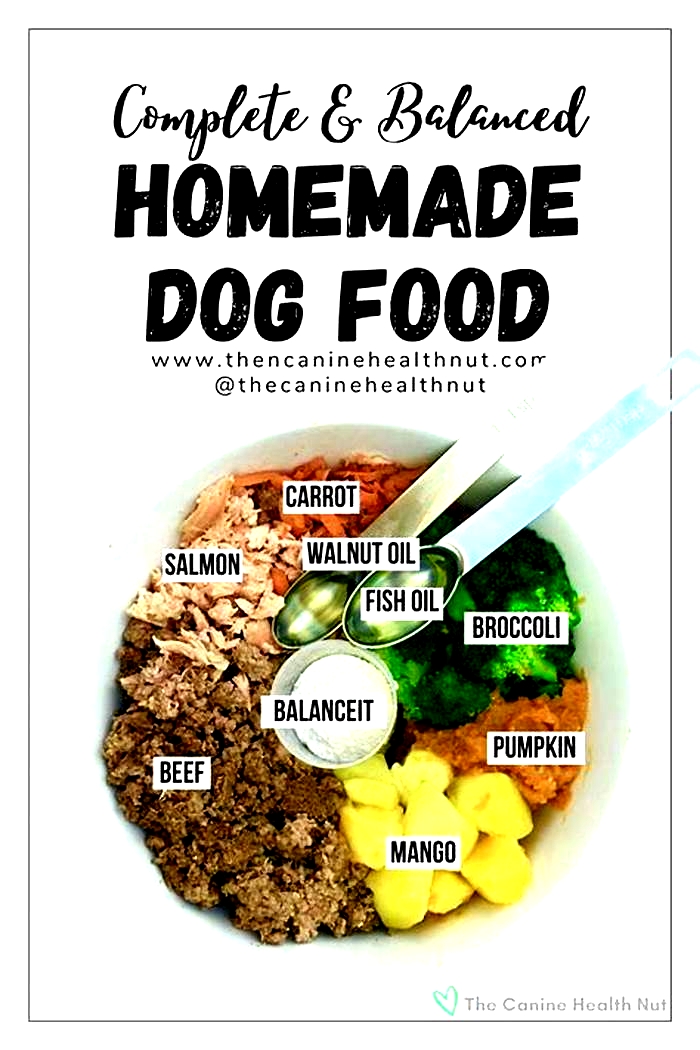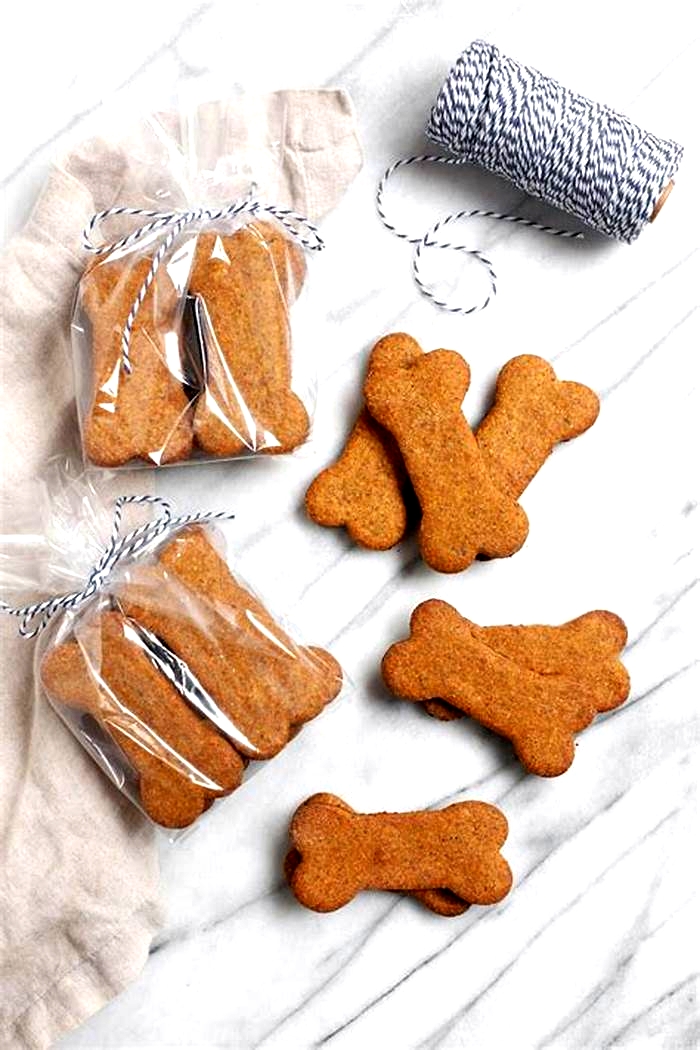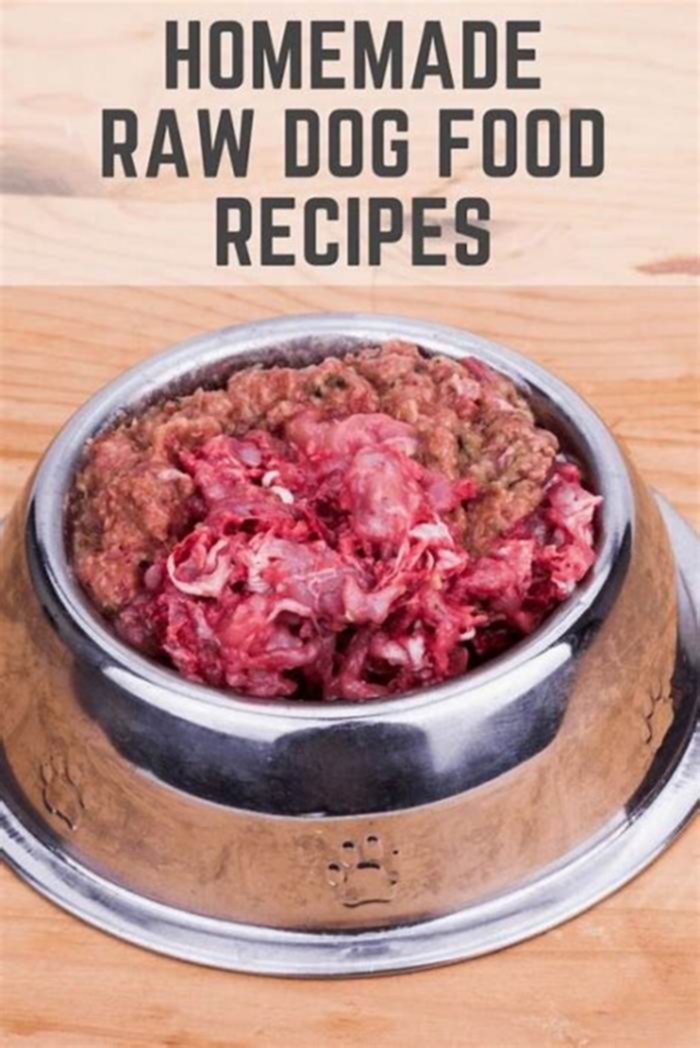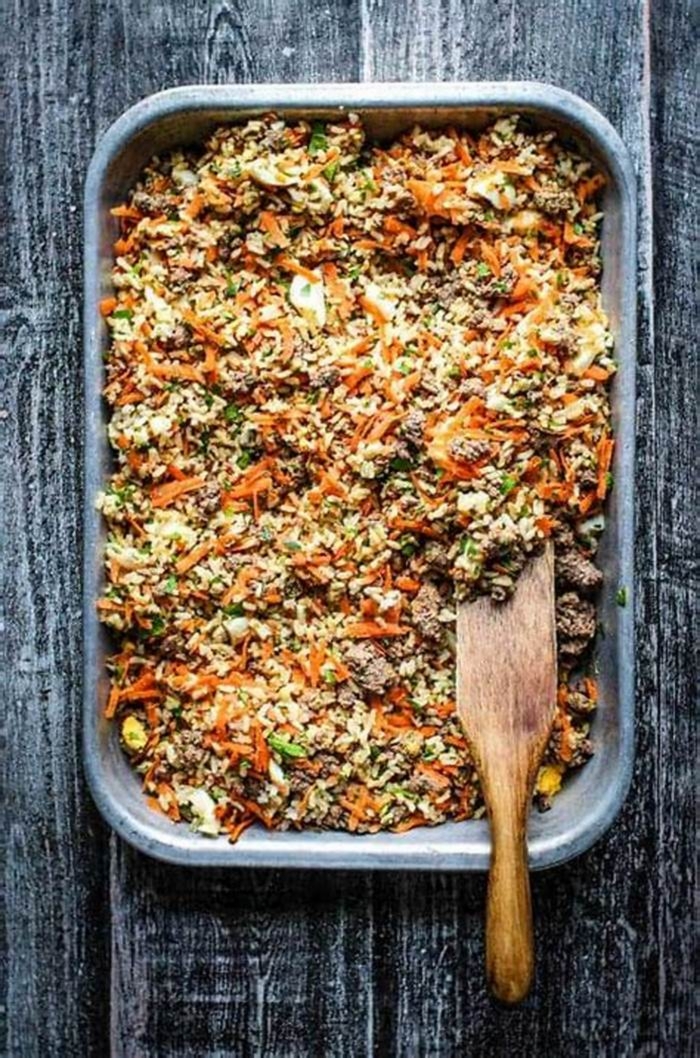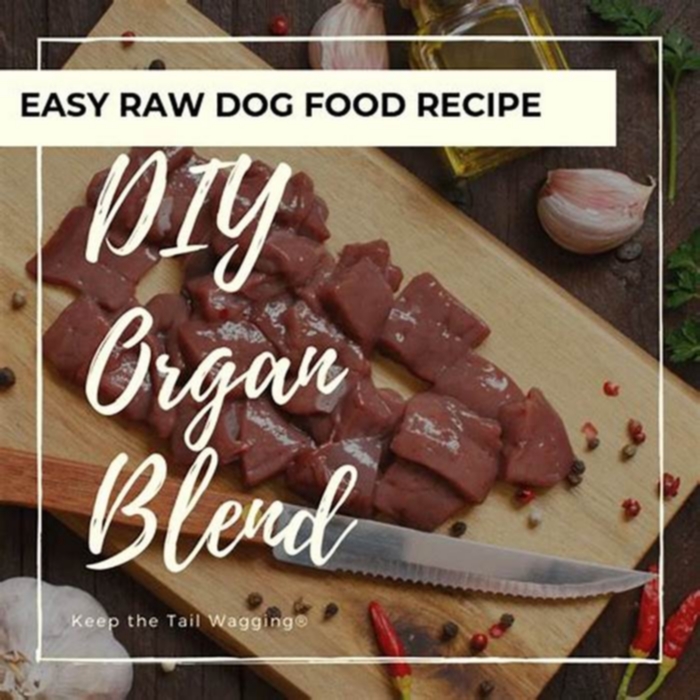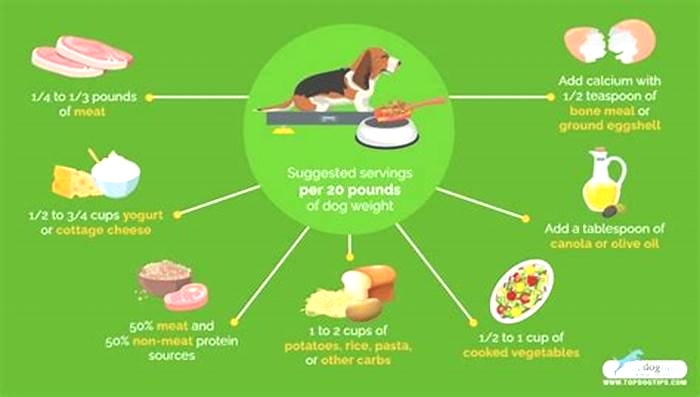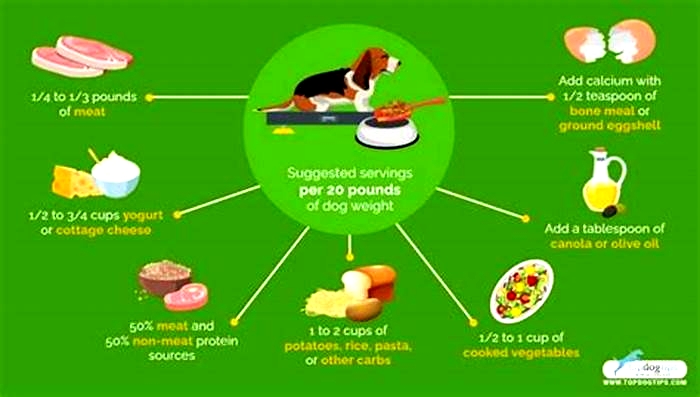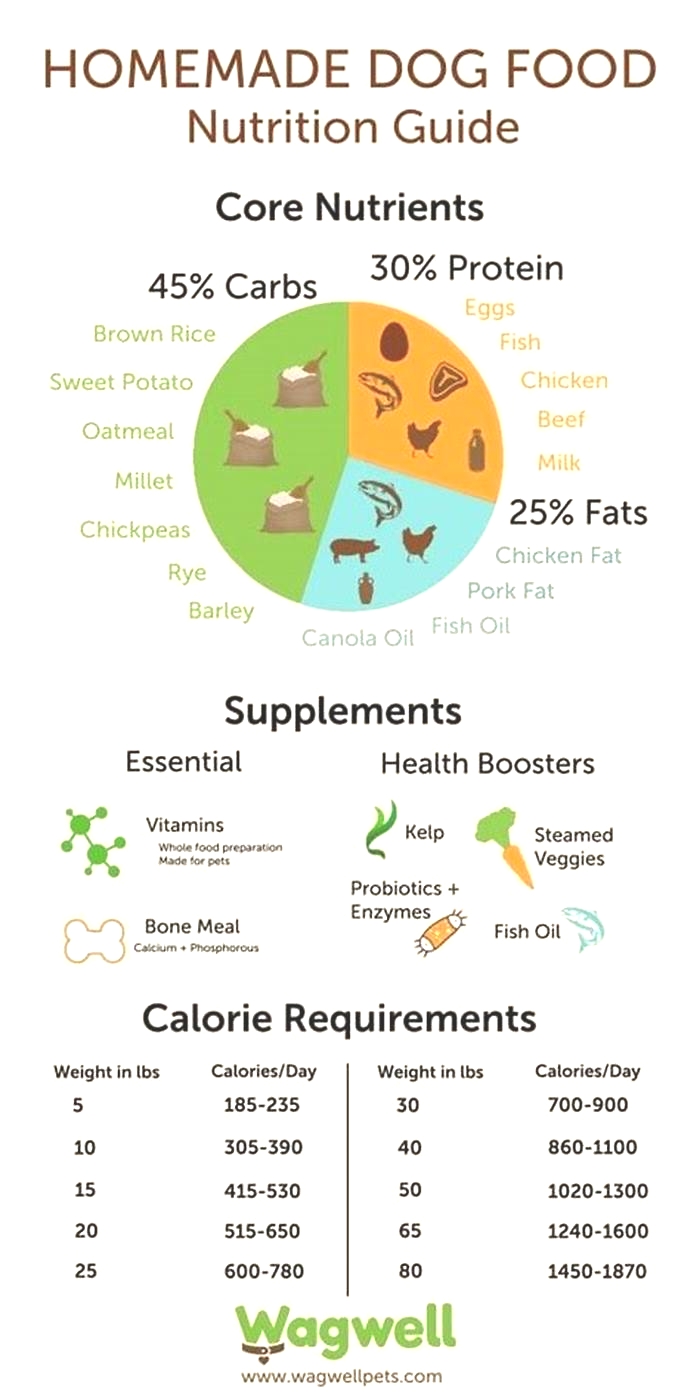homemade dog food meat to rice ratio
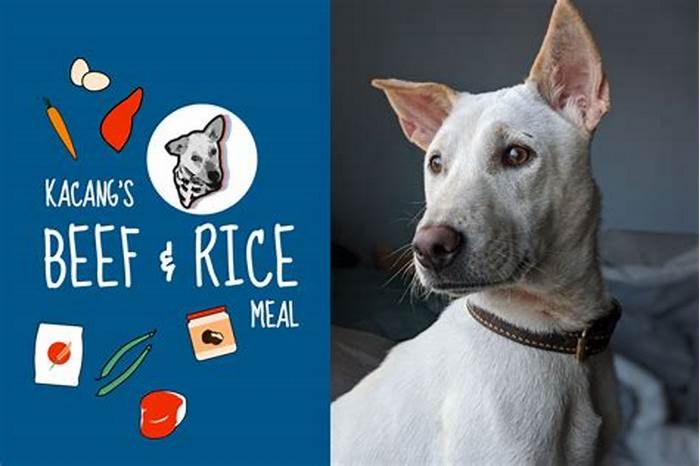
What Is the Ratio for Rice & Meat for Dogs?
Feeding your dog a homemade diet is not as simple as offering him leftovers from your dinner or a piece of meat in his dish. To meet his nutritional needs, your dog needs a balanced blend of protein, fiber, carbohydrates and fat. You want to balance a lean meat with a complex carb -- such as rice -- and other nutrients.
Meat
Meat provides your dog with protein for building muscles as well as necessary vitamins and nutrients, such as iron, vitamin B, magnesium and zinc. Lean meats are best for your dog; consider turkey, chicken, fish or pork. Lean cuts of beef or lowfat ground beef are suitable. Meat or protein should make up 30 percent to 40 percent of your dog's diet.
Rice
Rice helps your dog feel full and satisfied after eating and provides carbohydrates his body needs to produce energy. Unlike simple carbohydrates, the complex carbohydrates in rice break down slowly so the body can use it over time instead of a sudden rise and fall. You can feed either brown or white rice, although brown is also a good source of fiber. Rice has vitamins K, E and B. Your dog's diet should consist of about 20 percent to 30 percent cooked rice or other complex carbohydrates.
Other Ingredients
After a meat and a complex carbohydrate, the remaining percentage of the dog diet should be non-starch vegetables such as carrots, spinach, broccoli, tomatoes, green beans or cauliflower. These vegetables provide fiber, vitamins, carotenoids and flavenoids, all of which are vital to your dog's health. For the purpose of determining the amount of vegetables to include, use uncooked weight.
Bland Diet
Dogs who have just had surgery or are recovering from gastrointestinal illness, such as parvovirus, need a special bland diet. Follow your veterinarian's advice for feeding in these situations. A bland diet generally eliminates the vegetables and consists of 50 percent boiled lean meat and 50 percent rice. Feed your dog small amounts several times a day and gradually transition him back to his regular diet once your veterinarian allows him to eat regular food.
Special Health Conditions
Some health conditions require a special diet. For example, if your dog has kidney problems he may need a low-protein diet. If you are feeding rice, meat and vegetables, this will require an adjustment in the ratio of rice to meat. You should work closely with your veterinarian or an animal nutritionist to formulate a diet that meets your dog's special health needs.
Beef and Rice Dog Food Recipe

This complete and balanced high protein beef and rice dog food recipe is a great option for moderately active dogs. This recipe is a great option for someone just starting to home cook for their dog. The entire recipe takes less than 45 minutes to cook from start to finish, including prep time. It also doesnt require any specialized equipment such as a meat-grinder, as we are using pre-ground meat.
Beef and rice dog food recipes are a great option for dogs with food allergies to poultry. And can also be a great choice for picky dogs as many dog prefer red-meat over other protein sources. This recipe is also fairly easy to mix together making it a great option for dogs with tend to pick-out foods that they dont enjoy.
The recipe today is formulated to AAFCO standards and is complete and balanced for adult dogs if all ingredients are prepared as listed and all supplements are included. If any changes are made to the recipe it will no longer be considered balanced and should be considered a treat or addition and be kept to 10% of your dogs overall daily caloric needs.
BEEF AND RICE DOG FOOD RECIPE INGREDIENTS
95% Lean Ground Beef: Lean ground beef is an excellent source of essential amino acids along with many different vitamins and minerals such as vitamin B12, zinc, selenium, iron, vitamin B6, niacin, and phosphorus.
Brown Rice: A great source of healthy fiber, an excellent source of manganese, magnesium, vitamin b6, vitamin b1, selenium, iron, and a good source of certain types of antioxidants such as phenols and flavonoids.
Spinach: Provides many different essential vitamins and minerals such as vitamin K, vitamin A, vitamin C, folate, manganese, magnesium, iron, and vitamin B2. Spinach also contains several antioxidants such as Quercetin and Kaempferol which can help reduce inflammation and oxidative stress.
Zucchini: A great source of antioxidants such as carotenoids (like lutein, zeaxanthin, and beta-carotene), and an excellent source of fiber to support a healthy microbiome.
Walnut Oil: An excellent source of linoleic acid and alpha-Linolenic acid which are essential fatty acids that dogs need in their diet.
Nordic Naturals Omega 3 Pet: A wonderful source of EPA and DHA, along with vitamin E. Nordic naturals fish oil is a purified, third party tested oil that has an excellent EPA to DHA ratio perfect for balancing out the higher omega 6 essential fatty acids found in the chicken and walnut oil.
Supplement (BalanceIT Canine): Without using the supplement this recipe will be deficient in riboflavin, thiamin, vitamin A, calcium, copper, iodine, and vitamin D.
DIET COMPOSITION
PERCENT CALORIE BASIS:
- Protein: 47%
- Fat: 28%
- Carbohydrate: 24%
- Moisture: 73%
- Calories: 961
BEEF AND RICE HOMEMADE DOG FOOD RECIPE
- 383g 95% lean ground beef, pan-broiled
- 106g Brown Rice, long-grain, cooked
- 45g Spinach, cooked boiled
- 90g Zucchini, cooked boiled
- tsp Walnut Oil
- tsp Nordic Naturals Omega 3 Pet
- 4 tsp BalanceIT Canine
HOW MUCH TO FEED
The amount that you feed your dog will be based on their individual metabolism and lifestyle needs. Calories needed can range up to 50% high or lower than the average amount and still be considered normal.
Overweight or obese dogs trying to lose weight should be fed to their ideal weight if your dog needs to lose weight please discuss your dogs individual caloric needs with your veterinarian.
The below chart is the average calories needed for a dog of a particular weight. If you are using this recipe as a treat the portion should be kept in the treat category. If feeding as a complete and balanced meal, you can either re-calculate the recipe using BalanceIT or feed according to your dogs caloric needs (average suggested amounts within the food category).
BEEF AND RICE DOG FOOD RECIPE COOKING INSTRUCTIONS
If you have a rice-cooker this recipe is going to be VERY simple to do. The recipe calls for about 1 cup of cooked brown rice. So start with about cup of dry rice, with 1 cup of water, and follow the directions on your rice cooker for perfect rice!
For this recipe you will need about 1 lb of 95% lean ground beef to start as it will loose water while cooking . Place the ground beef in a nonstick pan (I prefer cast iron), and cook until lightly browned. DO NOT ADD OIL while cooking. We do not want to add any extra fat to the recipe.
In a separate stainless steel pan add 1 cup of water and boil. Chop up about 180g of Zucchini (about 1 large), and add it to the boiling water. Cover and allow to soften for about 3 minutes, then drain and set aside to cool. In the same pan add a 1/2 of water and boil. Then add in spinach mix until softened, then drain and cool.
ALL INGREDIENTS SHOULD BE MEASURED AFTER COOKING.
Depending on your dogs size you can add everything into a food processor prior to feeding. Another option is you can chop all elements into bite-sized pieces and mix together.
Allow everything to cool prior to feeding or adding any additional supplements. I highly recommend if you are batch-cooking meals for your dogs to portion all ingredients EXCEPT oils and supplements into containers. Then add supplements and oils the day-of feeding. This will keep everything fresh, and allow you to reheat the food if needed prior to serving. However if you find it easier to have everything mixed in that should be okay. Do not reheat any food items after supplements or oils are added.
The food should be fine in the fridge for about 3 days, and in the freezer for about 30 days. If you plan to make even larger batches I would highly recommend a deep-freezer and vacuum sealable bags. As otherwise the food may start to loose nutritional value and get freezer burn.
NEED HELP CUSTOMIZING TO YOUR PET?
Are you having problems customizing this recipe to your own dogs nutritional needs? Unsure of if this dog food recipe is a good fit for you dog? Or maybe you would prefer a recipe using less supplementation? As a home cooker of over 5 years who has helped hundreds of pet parents transition to fresh food, Id be more than happy to help you answer your canine nutrition questions, set up a meal plan for your dog, or even just talk about the logistics of feeding fresh food. Feel free to reach out with questions, or schedule a nutritional consultation today.

About the Author: Nikki is a Registered Veterinary Technician (Veterinary Nurse) and Dog Mom with over a decade of experience with dogs and cats. Since graduation from college (BS Biology, Dip. Animal Nutrition, AS Animal Science) she has adopted two mixed breed dogs Ranger and Ash, and has focused her time learning about pet food and nutrition.
Nikki shares information on a range of pet nutrition topics: from how to create a homemade complete and balanced dog and cat food recipes, to how to choose a pet food. Nikki strives to give dog and cat parents the information they need in order to make the best nutrition decisions for their pet!
You should receive your Free Dog Food Recipe Ebook within 24 hours of subscribing! Make sure to check your spam folder. The recipe ebook is over 90 pages long so make sure you have a good internet connection when you go to download it. Afterwards you will receive weekly Canine Nutrition Updates every Tuesday on different topics related to canine nutrition & homemade dog food!
CONTACT ME:


Homemade Dog Food Recipe Beef and Sweet Potato: using lean ground beef, sweet potatoes, carrots, bell pepper, walnut oil, fish oil and balanceIT supplement.

Homemade Dog Food Recipe Chicken and Quinoa: using chicken breast, chicken thighs, spinach, blueberries, walnut oil, fish oil and balanceIT supplement.

Homemade Dog Food Recipe Fish and Sweet Potato: using cod, salmon, sweet potatoes, carrots, broccoli walnut oil, and balanceIT supplement.
Homemade Dog Food Calculator
Providing fresh, homemade food for your dog is one of the best things that you can do for his health and well-being and you can do it using a homemade dog food calculator.
Whenever pet owners broach this subject with me, they often bring up how difficult a homemade dog food calculator can be.
Yes, creating recipes to meet your dog's nutritional needs can be a challenge. But, thishomemade dog food recipe calculator will make the process a little easier.
Many pet owners believe that they can feed their dog the same quantity of homemade food as recommended by their old commercial kibble brand.
That could not be more wrong!
Homemade dog food is more nutritionally dense than most commercial foods. This means that your dog won't need as much to get the same nutritional benefits.
I've also heard pet owners share misinformation about watching a dog's weight and adjusting the serving sizes accordingly. That's why it is important to use a homemade dog food calculator.
If the dog is gaining weight, lessen the serving size. If he's losing weight, increase the serving size.
Why Do We Calculate Dog Food?
 The consequences of feeding your dog too much food are obvious.He'll become obese, which could lead to a slew of other health conditions like diabetes, joint problems, certain types of cancer, and heart and respiratory issues.
The consequences of feeding your dog too much food are obvious.He'll become obese, which could lead to a slew of other health conditions like diabetes, joint problems, certain types of cancer, and heart and respiratory issues.
Did you know that feeding your dog too much food can also lead to nutrient toxicity? In the case of nutrition, too much of a good thing could be very bad! For example, Vitamin A toxicity can cause bone spurs, lethargy, constipation, stiffness, and limping.
On the other hand, if you're not feeding your dog enough, he couldbecome nutrient deficientquite quickly. If you don't realize your dog isn't getting the proper nutrients, he may become weak and his organs could start to fail. Ultimately, nutrient deficiency can lead to death if it's not corrected.
In short, it's crucial that you discuss a switch in your dog's nutrition with your veterinarian. It's also important to use this homemade dog food recipe calculator as a guideline for figuring out how much food to feed Fido at each serving.

Calculating Homemade Dog Food Recipe

The first thing you'll need to do when following a homemade dog food recipe calculator is to figure out your pet'sDaily Energy Requirements (DER). This is the amount of energy (also called calories) that your dog's body burns in a typical day.
Before you can find the DER, you'll need to find Fido's Resting Energy Requirement (RER).RER is the energy that your pooch needs to perform essential bodily functions like heart functions, brain functions, digestion, and respiration.
To find your dog's RER, you'll need to multiply his body weight in kilograms raised to the 3/4 power by 70. In equation form this looks like this:
70(body weight in kg. ^.75)
Let's take a look at an example. If your dog weighs 53 pounds, that converts to 24 kg. Now, raise 24 to the .75 power and you get 11.2 (rounded to the nearest tenth). The last step is multiple 70 x 11.2, which equals 784. A 53-pound dog's RER is 784.
Once you figure out the RER, you can move on to the DER. This gets a little trickier. To find the DER, you'll need to multiple the RER by a certain factor that meets Fido's description.
According to The Ohio State University Veterinary Medical Center, these are the factors that you can choose from:
| Neutered adult | =1.6 x RER |
| Intact adult | =1.8 x RER |
| Inactive/obese prone | =1.2-1.4 x RER |
| Weight loss | =1.0 x RER for ideal weight |
| Weight gain | =1.2-1.8 x RER for ideal weight |
| Active, working dogs | =2.0-5.0 x RER |
| Puppy 0-4 months | =3.0 x RER |
| Puppy 4 months to adult | = 2.0 x RER |
Summary of Homemade Dog Food Calculator
Remember, these are just estimates. They can vary by as much as 50%, so you have to understand that these numbers are just a general starting point. The best thing that you can do is discuss your homemade dog food diet with your veterinarian or a canine nutritionist who can help you understand your dog's caloric needs better.
READ NEXT: How Seasons Affect Your Dog's Dietary Needs

